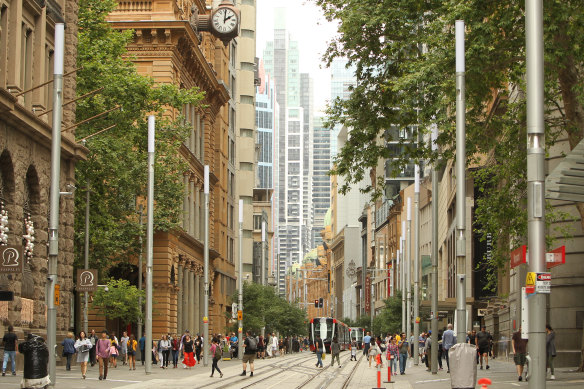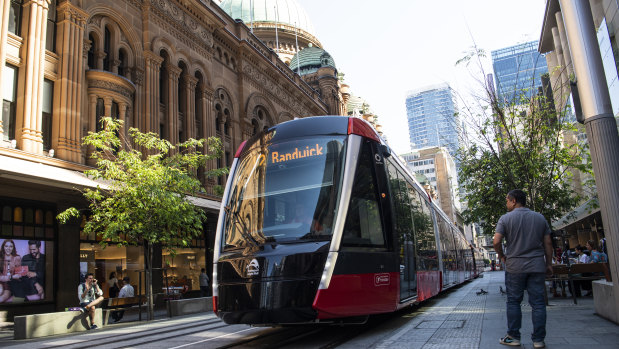- Explainer
- National
- NSW
- Public transport
Explainer
Sydney's light rail finally opens: what you need to know about trams
It has been one of Sydney's most troubled public transport projects.
From Saturday, Sydneysiders get a chance to decide for themselves whether construction of the light rail along one of Australia's oldest streets to the eastern suburbs has been worth the cost blowouts, repeated delays, legal battles and disruption to businesses and residents.

Sydney's light rail line has transformed George Street in the CBD.Credit: Jacky Ghossein
Almost six decades after the last of Sydney's extensive tramway system was ripped up, the opening to passengers at 11am of the new light rail line from Circular Quay to Randwick – dubbed L2 – marks a shift towards greater use of public transport in the city.
It has allowed a large part of George Street to be turned into a "pedestrian boulevard" as trams replace buses that once formed conga lines along one of the CBD's best-known strips.
Yet amid the celebration of trams carrying passengers will come the next big test of a promise born out of the NSW Coalition's return to government in 2011.
What will trips cost?
While the trams will be free for the opening weekend, standard distance-based light rail Opal fares will start from Monday.
A holder of an adult Opal card will pay $3.73 for a one-way journey from Circular Quay to Randwick. (A one-way journey from the CBD to Kingsford will be the same once a branch of the line known as L3 opens in March.)
A shorter trip from Circular Quay to stops along George Street such as Town Hall will cost $2.24.
Adult Opal card holders and users of contactless cards will get a $2 transfer discount when they switch from trains, buses or ferries to the light rail within 60 minutes of their last tap off.
Transport for NSW said fares were calculated by "straight line distance between tap on and off locations". The fares for the CBD and South East Light Rail are the same as the Inner West Light Rail from Central Station to Dulwich Hill, known as L1.
How long will the trip take?
Several months ago, traffic modelling by the state's transport agency was estimating a journey along the full length of the line between Circular Quay and Randwick would take 38 to 40 minutes.
But the consortium responsible for delivering the project has since advised that the "initial" trips from one end to the other will take about 50 minutes. The longer trip times have been partly blamed on tram drivers having to reduce speeds on George Street because "some pedestrians are still not behaving safely near light rail".
It means the trams will be about 20 minutes slower than catching a bus between Circular Quay and the centre of Randwick during the early months of operation.
The transport agency has vowed to work to "improve the journey time as we fine tune light rail’s integration" into Sydney's traffic and transport network.
The speed limit for trams in pedestrians zones such as the one in George Street is 20 kilometres an hour, and 40km/h for the rest of the line from Circular Quay to Moore Park.
How often and when will they run?
Once the branch line to Kingsford opens, trams will run as frequently as every four minutes in either direction, and every eight minutes along the rest of the line from 7am to 7pm.
Before then, trams will run every four to eight minutes between Circular Quay and Central, and every eight to 12 minutes between Central and Randwick from 7am to 7pm.
All up, the line will operate from 5am to 1am on both the L2 Randwick Line and, when it opens, the L3 Kingsford Line.
However, the government has said it is open to considering running services later at night on weekends to "meet the needs of the night-time economy" following a relaxation of lockout laws.
Extra tram services will be put on during special events such as cricket Tests at the Sydney Cricket Ground.

The trams will run from 5am to 1am seven days a week. Credit: Louise Kennerley
How many seats will there be?
Every 67-metre tram is able to carry up to 450 passengers, which includes 96 seated.
But the number of seats can be increased to 120 when passengers sit on flip seats. That reduces slightly the standard carrying capacity of the trams – among the longest in the world and almost four times as long as a bendy bus – because it means fewer people can stand.
Once the line is fully operational, the government forecasts the trams will have capacity to carry 13,500 passengers an hour – 6750 in either direction – during peak periods of the day.
What will happen to bus services?
The government has decided to delay major changes to bus services in the south-east until April.
One of the main reasons for the delay is that trams will not start running along the branch line to Kingsford, and past the University of NSW campus on Anzac Parade, until March.
While express buses during peak periods will be maintained after April, others are set for a shake-up due to the increase in public transport capacity from the trams.
Why do they call them light rail vehicles and not trams?
While they are "trams" to most people, the 67-metre double-sets are "light rail vehicles" to those in the transport industry.
Sydney Tram Museum director Greg Sutherland said the term "light rail" began to be used in the US decades ago as a marketing tool by those pushing for tramways to be built.
"Over time as tramway systems closed down, the word 'tram' started to be used pejoratively, particularly by those pushing for more roads," he said.
That led to the industry seeking to put a more favourable spin on trams.
"Light rail is a marketing term rather than a reality. The current vehicles have actually evolved from what were originally known as trams," he said.
He favours calling them "trams". After all, a short term will often suffice.
What will the final cost of the project be?
The project has been a political and financial headache for the Berejiklian government.
Budgeted to cost $1.6 billion in 2014, the bill for taxpayers has since ballooned to at least $2.9 billion after a third cost blowout last month.
In 2014, the cost surged to $2.1 billion due to mis-pricings and omissions in the business case and, in June this year, it blew out to $2.7 billion after the government settled claims with the consortium delivering the project and its Spanish construction contractor.
As part of the settlement in June, the ALTRAC consortium's 15-year contract to operate and maintain light rail services was extended by two years to 2036, which means it will collect revenue from the government for longer than planned.
The additional cost to the government of paying the private consortium to operate the line for 15 years had previously been put at almost $938 million. It is separate to the capital cost of building the line and buying the trams that will run on it.
The final cost of building the line could increase further if retailers disrupted by construction are successful in their $400 million class action in the NSW Supreme Court.
Is it all going to work?
The complexity of running trams through the heart of Sydney cannot be overstated.
In fact, Transport for NSW coordinator general Marg Prendergast said the start of passengers services was a bigger challenge than the opening of Sydney's $7.3 billion Metro Northwest line in May, and even harder than managing transport during the Sydney Olympics.
Thousands of pedestrians crossing the light rail line in George Street every hour, in addition to motorists and cyclists, underscores the challenge in ensuring trams operate on time.
And while tram testing over the past six months has helped to iron out kinks, human nature is difficult to predict and a new set of hurdles will emerge once people hop on board.
"The key element will be ultimately how the city gets used to the rhythm of it," Transport Minister Andrew Constance said.
So it is not surprising that the government has sought to manage expectations by warning it will take up to six months to "bed down" services.
Let us explain
If you'd like some expert background on an issue or a news event, drop us a line at explainers@smh.com.au or explainers@theage.com.au. Read more explainers here.